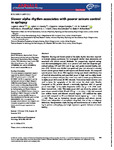Slower alpha rhythm associates with poorer seizure control in epilepsy
| dc.contributor.author | Abela, E | |
| dc.contributor.author | Pawley, AD | |
| dc.contributor.author | Tangwiriyasakul, C | |
| dc.contributor.author | Yaakub, Siti Nurbaya | |
| dc.contributor.author | Chowdhury, FA | |
| dc.contributor.author | Elwes, RDC | |
| dc.contributor.author | Brunnhuber, F | |
| dc.contributor.author | Richardson, MP | |
| dc.date.accessioned | 2023-02-20T14:56:00Z | |
| dc.date.issued | 2018-12-18 | |
| dc.identifier.issn | 2328-9503 | |
| dc.identifier.issn | 2328-9503 | |
| dc.identifier.uri | http://hdl.handle.net/10026.1/20480 | |
| dc.description.abstract |
<jats:title>Abstract</jats:title><jats:sec><jats:title>Objective</jats:title><jats:p>Slowing and frontal spread of the alpha rhythm have been reported in multiple epilepsy syndromes. We investigated whether these phenomena are associated with seizure control.</jats:p></jats:sec><jats:sec><jats:title>Methods</jats:title><jats:p>We prospectively acquired resting‐state electroencephalogram (<jats:styled-content style="fixed-case">EEG</jats:styled-content>) in 63 patients with focal and idiopathic generalized epilepsy (<jats:styled-content style="fixed-case">FE</jats:styled-content> and <jats:styled-content style="fixed-case">IGE</jats:styled-content>) and 39 age‐ and gender‐matched healthy subjects (HS). Patients were divided into good and poor (≥4 seizures/12 months) seizure control groups based on self‐reports and clinical records. We computed spectral power from 20‐sec <jats:styled-content style="fixed-case">EEG</jats:styled-content> segments during eyes‐closed wakefulness, free of interictal abnormalities, and quantified power in high‐ and low‐alpha bands. Analysis of covariance and post hoc <jats:italic>t</jats:italic>‐tests were used to assess group differences in alpha‐power shift across all <jats:styled-content style="fixed-case">EEG</jats:styled-content> channels. Permutation‐based statistics were used to assess the topography of this shift across the whole scalp.</jats:p></jats:sec><jats:sec><jats:title>Results</jats:title><jats:p>Compared to HS, patients showed a statistically significant shift of spectral power from high‐ to low‐alpha frequencies (effect size <jats:italic>g</jats:italic> = 0.78 [95% confidence interval 0.43, 1.20]). This alpha‐power shift was driven by patients with poor seizure control in both <jats:styled-content style="fixed-case">FE</jats:styled-content> and <jats:styled-content style="fixed-case">IGE</jats:styled-content> (<jats:italic>g</jats:italic> = 1.14, [0.65, 1.74]), and occurred over midline frontal and bilateral occipital regions. <jats:styled-content style="fixed-case">IGE</jats:styled-content> exhibited less alpha power shift compared to <jats:styled-content style="fixed-case">FE</jats:styled-content> over bilateral frontal regions (<jats:italic>g</jats:italic> = −1.16 [−0.68, −1.74]). There was no interaction between syndrome and seizure control. Effects were independent of antiepileptic drug load, time of day, or subgroup definitions.</jats:p></jats:sec><jats:sec><jats:title>Interpretation</jats:title><jats:p>Alpha slowing and anteriorization are a robust finding in patients with epilepsy and might represent a generic indicator of seizure liability.</jats:p></jats:sec> | |
| dc.format.extent | 333-343 | |
| dc.format.medium | Electronic-eCollection | |
| dc.language | en | |
| dc.language.iso | eng | |
| dc.publisher | Wiley | |
| dc.subject | Adolescent | |
| dc.subject | Adult | |
| dc.subject | Alpha Rhythm | |
| dc.subject | Electroencephalography | |
| dc.subject | Epilepsy | |
| dc.subject | Epilepsy, Generalized | |
| dc.subject | Female | |
| dc.subject | Frontal Lobe | |
| dc.subject | Humans | |
| dc.subject | Image Processing, Computer-Assisted | |
| dc.subject | Male | |
| dc.subject | Middle Aged | |
| dc.subject | Seizures | |
| dc.subject | Young Adult | |
| dc.title | Slower alpha rhythm associates with poorer seizure control in epilepsy | |
| dc.type | journal-article | |
| dc.type | Journal Article | |
| dc.type | Research Support, Non-U.S. Gov't | |
| plymouth.author-url | https://www.webofscience.com/api/gateway?GWVersion=2&SrcApp=PARTNER_APP&SrcAuth=LinksAMR&KeyUT=WOS:000459708100012&DestLinkType=FullRecord&DestApp=ALL_WOS&UsrCustomerID=11bb513d99f797142bcfeffcc58ea008 | |
| plymouth.issue | 2 | |
| plymouth.volume | 6 | |
| plymouth.publication-status | Published | |
| plymouth.journal | Annals of Clinical and Translational Neurology | |
| dc.identifier.doi | 10.1002/acn3.710 | |
| plymouth.organisational-group | /Plymouth | |
| plymouth.organisational-group | /Plymouth/Faculty of Health | |
| plymouth.organisational-group | /Plymouth/Faculty of Health/School of Psychology | |
| plymouth.organisational-group | /Plymouth/Users by role | |
| plymouth.organisational-group | /Plymouth/Users by role/Academics | |
| dc.publisher.place | United States | |
| dcterms.dateAccepted | 2018-11-26 | |
| dc.rights.embargodate | 2023-2-21 | |
| dc.identifier.eissn | 2328-9503 | |
| dc.rights.embargoperiod | Not known | |
| rioxxterms.versionofrecord | 10.1002/acn3.710 | |
| rioxxterms.licenseref.uri | http://www.rioxx.net/licenses/all-rights-reserved | |
| rioxxterms.licenseref.startdate | 2019-02 | |
| rioxxterms.type | Journal Article/Review |


